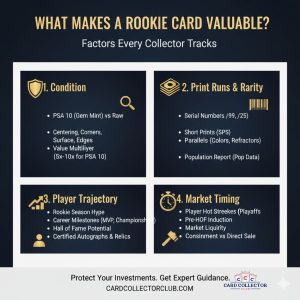Thinking about which rookie cards in your collection are worth investing in, holding long-term, or submitting for grading? The potential value of a rookie card is driven by a dynamic mix of the player’s performance, the card’s rarity, and its physical condition. In this guide, we’ll break down the four critical factors that dictate a rookie card’s market price, knowledge every serious collector needs.
The Four Pillars of Rookie Card Value

From vintage legends to modern stars, the principles of value remain the same. Understanding these factors is key to successful collecting and investment.
1. Condition: Why Grading is Non-Negotiable
The single most significant determinant of a modern or vintage rookie card’s price is its condition, as certified by a professional grading service. A raw, pack-fresh card may look perfect, but only a Gem Mint (PSA 10) or Mint (PSA 9) grade will unlock its true market potential.
What Graders Look For:
- Centering: Is the image perfectly aligned within the borders? Poor centering (e.g., 60/40) immediately drops the grade.
- Corners: Are all four corners sharp, or are they rounded, dinged, or fuzzy? Even minor fraying impacts the score.
- Surface: Are there print defects, scratches, wax stains, or scuffs?
- Edges: Are the edges clean and smooth, or chipped/rough-cut?
In our experience, a jump from a PSA 9 to a PSA 10 (Gem Mint) grade can result in a 5x to 10x multiplier on the card’s value, especially for high-demand rookies. This disparity is why professional authentication and slabbing are critical.
Ready to maximize the value of your rookies? Learn about our industry-leading process: Grading Services
2. Print Runs & Rarity (The Population Factor)
A card’s scarcity is its fuel for high value. In the modern card market, print runs are clearly defined by serial numbering (e.g., ). For vintage cards, rarity is determined retroactively based on how many clean copies survived (The “Population Report”).
Rarity Tiers to Track:
- Short Prints (SPs): Cards intentionally printed in lower quantities than the base card.
- Parallels: Color, pattern, or finish variations of the base rookie card (e.g., Prizm Gold, Topps Chrome Refractor). Lower serial numbers (less) command the highest premiums.
- Population Data: Based on population data from PSA’s registry, if a card has a low total submission count and a low number of PSA 10s, it indicates extreme scarcity and drives value.
3. Player Trajectory and Performance
A rookie card is a bet on a player’s future. Value is inextricably tied to a player’s career arc. A card’s market history often follows a predictable pattern:
- Initial Hype: The card sells well upon release, based on amateur performance and draft position.
- Rookie Season Surge: Prices peak mid-season during a strong performance run.
- Career Fluctuation: The price settles and then rises or falls based on awards, championships, injuries, or milestones.
A key indicator of long-term value is a player’s hall-of-fame-level performance. A rookie card featuring a player who won MVP, multiple championships, or set major records will permanently cement its place as a collector’s cornerstone. Cards featuring desirable additions, such as a certified autograph or game-used relic, add another layer of value, which is also authenticated and graded.
4. Market Timing and Liquidity
When you sell, and how you sell, matters. The highest prices are often achieved when a player is hot, for instance, right before a major playoff series, following an award win, or immediately after a high-profile trade.
| Card Status | Market Timing/Liquidity Tip |
| Graded PSA 10 | Sell during peak player performance or pre-Hall-of-Fame induction hype. |
| High-End Raw Card | Sell right before the season starts to a dealer, or grade it first. |
| Low-Pop Serial Number | Consign to a trusted partner for maximum exposure and bidding competition. |
Coming soon to the App: Maximize your sales with expert guidance and access to high-net-worth buyers through our Card Consignment Service. Register Today
FAQs: Collector Intelligence for Informed Decisions
Is it worth grading base rookie cards?
A: Generally, no. Only cards with inherent rarity (parallels, serial-numbered cards, short prints) or extremely high value (e.g., Michael Jordan ’86 Fleer) are worth the grading cost, especially for modern base issues with massive print runs. Only submit raw cards that have a real chance at a PSA 9 or 10 grade.
How does the centering grade impact value the most?
A: Centering is the most visible flaw. A card with poor centering is highly distracting to the eye. For modern cards, anything less than centering front and back severely limits the top grade, often forcing a collector to seek a replacement copy, thus driving down the value of the flawed card.
Protect Your Assets: Submit For Grading Today
A rookie card’s value is a three-way intersection of Player Trajectory, Condition, and Rarity. You control the condition by how you handle and store your cards, and you control the rarity by selecting the right parallel. Don’t leave value on the table.
We offer secure, expert authentication and submission services, ensuring your most prized rookie cards are protected, certified, and valued correctly by the industry’s most trusted services.
CTA: Protect your rookie cards, submit for grading today.
